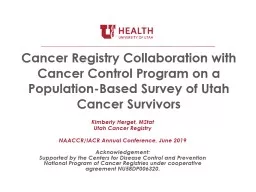

Kimberly Herget MStat Utah Cancer Registry NAACCRIACR Annual Conference June 2019 Acknowledgement Supported by the Centers for Disease Control and Prevention National Program of Cancer Registries under cooperative agreement NU58DP006320 ID: 913383
Download Presentation The PPT/PDF document "Cancer Registry Collaboration with Cance..." is the property of its rightful owner. Permission is granted to download and print the materials on this web site for personal, non-commercial use only, and to display it on your personal computer provided you do not modify the materials and that you retain all copyright notices contained in the materials. By downloading content from our website, you accept the terms of this agreement.
Slide1
Cancer Registry Collaboration with Cancer Control Program on a Population-Based Survey of Utah Cancer Survivors
Kimberly Herget, MStat
Utah Cancer Registry
NAACCR/IACR Annual Conference, June 2019
Acknowledgement:
Supported by the Centers for Disease Control and Prevention National Program of Cancer Registries under cooperative agreement NU58DP006320.
Slide2Background
Slide3Cancer Patient Health Status
Cancer registry data does a good job of collecting information at time of diagnosis
Beyond survival time, cancer registries do not collect information on patients long term after diagnosis
Slide4Identifying Cancer Survivor Needs
State cancer control programs have a need for a comprehensive understanding of cancer survivors’ experiences
Data are needed to evaluate those programs
Slide5Identifying Cancer Survivor Needs
Previous assessments in 2010 and 2017 via the Behavioral Risk Factor Surveillance System (BRFSS) cancer survivor module
Limitations of BRFSS
Self-reported cancer status
Many responders are non-melanoma skin cancer survivors
Anonymous so it cannot be linked to diagnostic information
Infrequent assessment
Collaboration between Utah Cancer Registry and the Utah Department of Health’s Comprehensive Cancer Program
Slide6Utah State Cancer Plan Goals for Cancer Survivors
Slide7Purpose
Slide8Assess trends of Utah cancer survivors’ long term health status and needs
Provide evidence to evaluate cancer control programs
Slide9Methods
Slide10Questionnaire Design
Input from relevant partners
Utah Department of Health
Utah Cancer Action Network
Huntsman Cancer Institute (National Cancer Institute designated Cancer Center)
Used many questions from BRFSS
Other questions were taken from validated survey instruments
Include questions relevant to the state cancer plan goals
Slide11Questionnaire Topic Areas
General health status
Health behaviors
Smoking status
Physical activity
Life satisfaction
Limitations due to physical, emotional, or mental health problems
Pain management
Treatment
Insurance payment for all/part of treatment
Survivorship care plan distribution
Enrollment in clinical trials
Caregivers
Health screenings
Slide12Survey Methods
Eligibility
Aged 18 or older at diagnosis
Diagnosed as a resident of Utah between 2012 and 2016
SEER-reportable invasive or benign brain/CNS tumor
Living in Utah in 2018
Sampling strategy
Sampled randomly from the Utah Cancer Registry
Identified 807 potential participants
Oversampled in areas with low health insurance coverage
Recruitment and data collection
$2 incentive for all participants sent with introductory letter
Participants aged 18 to 79 years sent a letter with link to an online survey
Participants aged ≥80 years sent a paper questionnaire
Non respondents were followed up by both phone and mail
Slide13Slide14Results
Slide15Table 1. Survey response and participant characteristics, 2018
Eligible Sample
Respondent
Response Rate
1
n
n
%
Total
807
485
60.7
Sex
Female
448
276
61.7
Male
359
209
59.4
Age at diagnosis
18 to 39 years
97
43
47.2
40 to 64 years
399
243
62.5
65 to 95 years
310
199
66.9
Insurance
Area
High
Insurance Coverage
292
196
66.2
Low Insurance
Coverage
515
290
53.1
1 Weighted
to account for stratified sample and age standardized
Slide16Table 1 continued. Participant characteristics, 2018
Eligible Sample
Respondent
Response Rate
2
n
n
%
Cancer Site
1
Breast
145
103
72.1
Melanoma
107
72
65.7
Prostate
138
86
64.3
Colorectal
70
36
45.5
Brain And Central Nervous System
62
22
37.9
O
ther Sites
138
86
64.3
Race
and Ethnicity
Non Hispanic White
734
460
63.2
Hispanic
55
20
40.5
All other races
18
6
26.5
1Five most sampled cancer sites shown
2 Weighted
to account for stratified sample and age standardized
Slide17Figure 1. Overall general health reported1
1 –
Weighted to account for stratified sample and age standardized
Slide18Figure 2. Pain caused by cancer or treatment1
1 –
Weighted to account for stratified sample and age adjusted
Slide19Figure 3. Limitations due to physical, mental, or emotional health
1 –
Weighted to account for stratified sample and age standardized
Slide20Conclusion
Slide21Discussion
Year one of this project has given us baseline data for understanding Utah cancer survivors’ health status
Reported pain varies by cancer site
Almost half of respondents have some limitations because of their physical or mental health
Slide22Next steps
Plan to collect data annually to assess trends
2019 data collection in progress
Oversample of Hispanic cases
Online and paper questionnaires now available in Spanish
Real time electronic death certificates will be used to avoid sending letters to deceased patients
Slide23Lessons Learned
High response rates can be achieved using a mixed mode protocol
online questionnaire first
mail and phone in subsequent follow-ups
prepaid incentive sent with study invitation
Pre-paid incentive requires extra administrative planning and quality control when mailing study invitations
Pre-notice letters identify bad/more current addresses before the study invitations containing the prepaid cash incentive are sent
Low response rate with benign cases as many respondents stated they ‘never had cancer’
Slide24Utah Cancer Registry staff who contributed to this project:
Judy Ou, PhD, Sandra Edwards, MS, Marjorie Carter, MS-MPH, Anne Kirchhoff, PhD, Morgan Millar PhD, Brad Belnap, BS, Carol Sweeney, PhD
Thanks to the study staff:
Kate Hak and Lori Burke
This work was supported by
the Centers for Disease Control and Prevention National Program of Cancer Registries under cooperative agreement NU58DP006320-02-00.
The Utah Cancer Registry is also supported in part by:
NCI Surveillance, Epidemiology, and End Results Program Contract No. HHSN261201800016I
University of Utah Health
Huntsman Cancer Institute
Acknowledgements